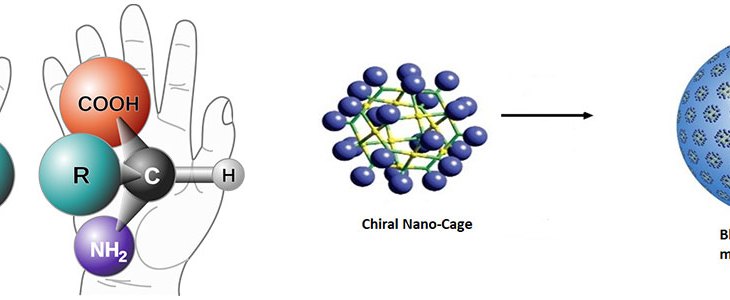How to Apply
Interested in participating in this research project? Contact the professor or graduate student listed below.
Professor
Dr. Tianbo Liu (Polymer Science) | tliu@uakron.edu
Graduate Student
Ehsan Raee | er60@zips.uakron.edu
Project Description

Chiral molecules are non-superimposable mirror images of each other similar to right and left hands (Figure 1). Two molecules of the same type with different chiralities possess the same physical and chemical properties; however, these pair of chiral molecules (you can call them enantiomers) rotate polarized light in different directions.

Amno-acids as building blocks of many basic biological molecules such as proteins, are chiral (except glycine). The interesting point about amino-acids forming proteins is that all of them involved in proteins structure are left-handed (L-amino-acid) (Figure 2). This is called “homochirality” or one-handedness. Although, scientists tried to present different theories explaining the reason of homochirality, but it is still a mystery that they think this mystery has happened at early stages of life evolution or at “the origin of life”.

Since proteins and their formation process are too complex to be studied phenomenologically, we use some chiral nano-cages to investigate the reason of homochirality. These nano-cages are able to form (self-assemble to) simple hollow sphere structures (let’s call them Blackberries) (Figure 3), which their formation is much easier to be studied compared to proteins.

One of interesting points during the formation of these Blackberries by chiral nano-cages is that in an anvironment consisting of left handed and right handed nano-cages (L-nano-cages and D-nano-cages), left handed nano-cages form left-handed Blackberries and right handed nano-cages form right handed Blackberries. It means that one left handed nano-cage looks for other left handed ones, recognizes them and invites them to form a Blackberry together (a left handed Blackberry); while, they don’t like right handed nano-cages and avoid them. The same thing happens for the right handed nano-cages. This is what we call “chiral recognition” meaning that chiral molecules recognize each other (Figure 4).
In our group, we use chiral nano-cages as simple models to explore what has happened during the early stages of life led to “homochirality” phenomena.
Project Dates
Fall 2019 and Spring 2020
Search Terms
Advanced Materials, For Credit, STEM
